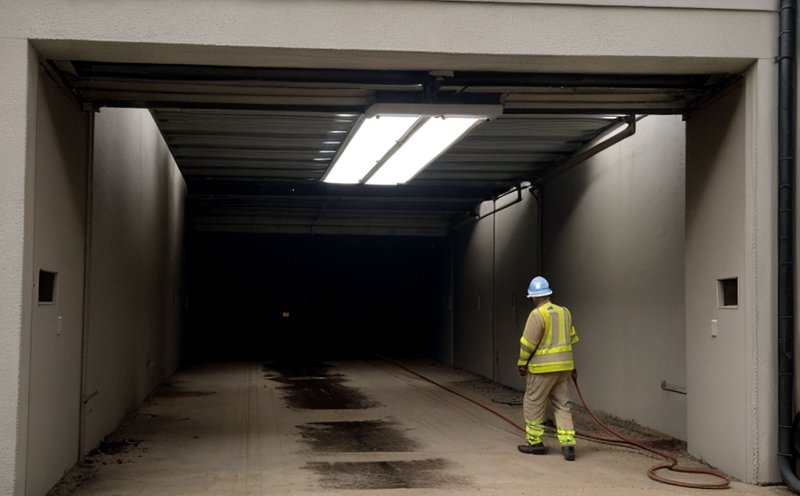Shutdown inspection
The shutdown inspection of HVAC and ventilation systems is a critical preventive maintenance measure that ensures safety, efficiency, and compliance with industry standards. This inspection is particularly important during periods when the system is not in operation, allowing for thorough examination without the interference of running components. During a shutdown, it's possible to identify issues such as wear and tear, potential leaks, or improper installation that might otherwise go unnoticed.
Quality managers, compliance officers, R&D engineers, and procurement teams often rely on this inspection to ensure that HVAC systems are in optimal condition before the next operational cycle. This service not only helps in maintaining the integrity of the system but also ensures that it meets all regulatory requirements and industry standards. Proper shutdown inspections can significantly extend the life of the equipment, reduce maintenance costs, and minimize downtime during future operations.
The process involves a detailed visual inspection of all components including air handlers, ductwork, filters, fans, and chillers. Instruments such as thermometers, manometers, and carbon dioxide meters are used to measure critical parameters like temperature, pressure, and humidity levels. The inspection also includes checking for any signs of corrosion or damage that could compromise the system's performance.
During a shutdown inspection, it is common practice to record all findings on standardized forms based on ISO 14064-2:2018, which provides guidelines for greenhouse gas inventories and carbon footprint calculations. This documentation ensures transparency and traceability of the inspection process, providing valuable data for future reference.
One key aspect of a shutdown inspection is the verification of the system's energy efficiency. Engineers use specialized software to simulate real-world operating conditions and compare them with actual performance metrics. This helps in identifying any discrepancies that could indicate inefficiencies or areas needing improvement.
The findings from these inspections are critical for decision-making processes related to maintenance schedules, capital expenditures, and operational strategies. By addressing potential issues early on, organizations can avoid costly repairs during peak usage periods and ensure a smoother transition back into service when the system is reactivated.
Scope and Methodology
| Component Inspection | Description |
|---|---|
| Air Handlers | Inspect for signs of corrosion, wear, and proper sealing. Check fan belts and motor alignment. |
| Ductwork | Look for any cracks or gaps that could lead to air leaks. Assess the insulation layers for integrity. |
| Filters | Evaluate their condition and determine if they need replacement based on usage and manufacturer recommendations. |
| Fans and Chillers | Inspect bearings, seals, and electrical connections. Ensure all components are clean and free from debris. |
The methodology for performing a shutdown inspection involves several steps to ensure comprehensive coverage of the HVAC system. First, the system is completely shut down to allow for thorough examination without any operational interference. Next, each component listed above undergoes detailed visual inspection using appropriate tools and equipment. Instruments such as thermometers are used to measure temperature gradients within different parts of the system. Carbon dioxide meters help assess ventilation efficiency.
Once all inspections are completed, a report summarizing the findings is prepared. This document includes a summary of observations made during the inspection along with recommendations for necessary actions. Compliance officers can use this information to update internal records and ensure ongoing adherence to relevant regulations.
Why Choose This Test
The decision to conduct a shutdown inspection is driven by several factors that contribute to overall system performance, safety, and compliance. Firstly, it allows for the identification of minor issues early on, preventing them from escalating into major problems later down the line. Secondly, it ensures that all components are in good working order before they resume operation, enhancing reliability and efficiency.
From a safety perspective, a thorough inspection during shutdown minimizes risks associated with operational hazards such as fires or equipment failures. Compliance officers can use this opportunity to verify that the system meets all relevant standards and guidelines set forth by authorities like ASHRAE (American Society of Heating, Refrigerating and Air-Conditioning Engineers).
Additionally, conducting regular shutdown inspections helps in optimizing energy consumption patterns. By monitoring how each component functions under non-operational conditions, engineers can fine-tune settings to achieve better results when the system is back online.
The cost-effectiveness of this service cannot be understated either. Early detection and rectification of faults prevent expensive repairs during peak usage periods or catastrophic failures that could cause significant disruptions. Furthermore, by extending the lifecycle of equipment through preventive maintenance, organizations save on replacement costs over time.
Use Cases and Application Examples
| Use Case | Description |
|---|---|
| Pre-Operational Check | Conduct a shutdown inspection prior to the start of a new season or major project. |
| Post-Maintenance Review | Perform after any significant repairs or upgrades have been made to ensure proper installation and functionality. |
| New Installation Verification | Evaluate newly installed HVAC systems for compliance with design specifications and performance criteria. |
| Daily/Weekly Monitoring | Implement periodic shutdown inspections as part of an ongoing maintenance program to maintain peak efficiency levels. |
In practice, a shutdown inspection serves multiple purposes depending on the specific requirements of each facility. For instance, some organizations may opt for pre-operational checks every year before the heating season begins or after significant renovations have been completed. Others might choose daily/weekly monitoring to keep track of system performance continuously.
A common application is in new installations where thorough verification is essential to confirm that everything has been installed correctly according to blueprints and codes. This ensures that all components work harmoniously together from the outset, setting a strong foundation for reliable operation throughout their lifespan.
The benefits extend beyond mere compliance; they encompass enhanced safety measures, improved energy efficiency, reduced maintenance costs, extended equipment life, and smoother transitions back into service post-inspection.





